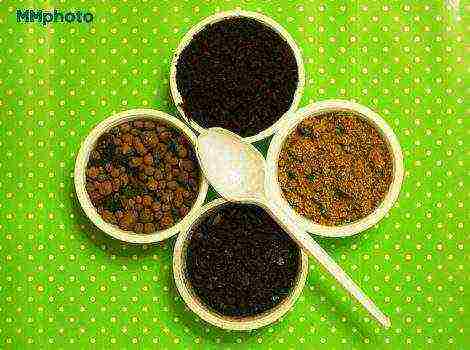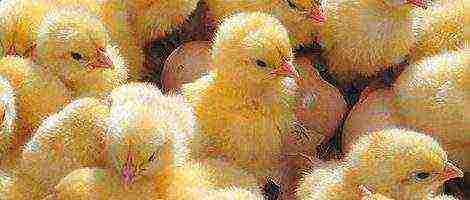Content
Flowers Olga Ravilova
|
2018-03-06 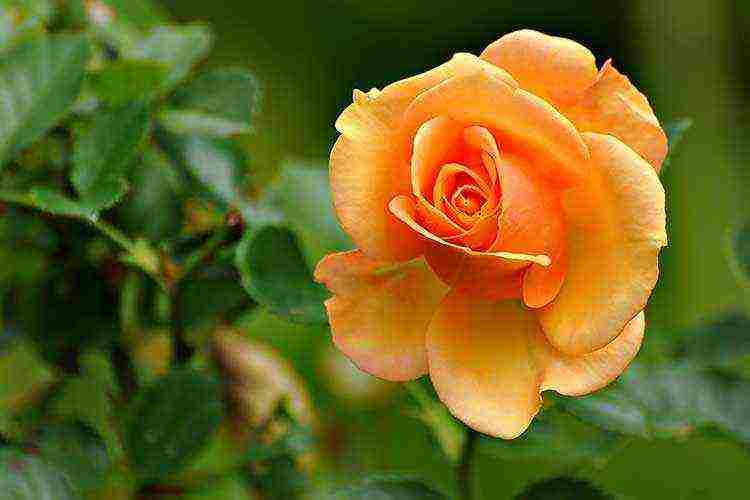 Among the many varieties of roses, there are varieties with peach flowers. Photo: Auntie Dogma's Garden Spot
Among the many varieties of roses, there are varieties with peach flowers. Photo: Auntie Dogma's Garden Spot
Rose is a shrub-shaped plant covered with thorns and pinnate leaves falling or evergreen, there are roses without thorns and in the form of lianas with shoots. Roses are superior to any other flower in shape, color and aroma of flowers. Therefore, the rose belongs to the most beautiful and perfect ornamental plants. More than 30,000 varieties of roses are known.
Roses are widely used in decorative landscaping of gardens and parks, in indoor culture and in greenhouses - pots and ground. The essential oil is obtained from the flowers of the rose, which is used for the best varieties of perfumes, and from the petals and fruits of the rose, excellent jam is made.
People have been cultivating roses as a cultivated plant since ancient times: long before our era, the cultivation of roses reached perfection in China and the Middle East. From China, the rose culture came to Ancient Greece, and later to Ancient Rome. Roses were widely known in Kievan Rus.
Roses are usually divided into rose hips and park roses; climbing roses; noble roses, based on the classification proposed by Professor N. I. Kichunov. This article will consider the most interesting roses for flower growers.
Noble roses
Noble roses unite many groups with thousands of cultivated varieties of roses, mostly non-hardy, grown in the northern regions and the Middle Belt. All noble roses are hybrid in origin, many of the noble roses are complex hybrids.
The main groups of noble roses:
- Tea roses;
- Monthly roses (noisette, bourbon);
- Repair roses;
- hybrid tea roses;
- Pernetsian roses;
- polyanthus roses.
The work on the development of new varieties of roses is most widely carried out in the Main Botanical Garden, where the richest collection of roses in our country is concentrated, and in the Kiev Botanical Garden. Much has been done in this direction in the Nikitsky and Odessa Botanical Gardens, which bred such varieties as Valentina Grizodubova and Dobrynya Nikitich (with pink flowers), Svyatogor (with salmon pink flowers), Polina Osipenko (with white flowers), in the Botanical Garden of Moscow State University, in Institute of Plant Industry in St. Petersburg.
Many flower breeders are engaged in the development of new varieties of roses. Of these, it should be noted: the laureate of the State Prize IP Kovtunenko (Nalchik), who created the well-known Pernetsian rose Kabardinka; A. Chernenko (Voronezh), who received a new variety of polyanthus rose "Voronezh Dawn"; MM Ulyanishchev, who bred several valuable varieties of roses; FR Gubonina (Moscow) - the author of new hybrid tea roses: N. K. Krupskaya, M. P. Nagibina and others; I. L. Zalivsky (St. Petersburg), who received such varieties of roses as Tamara and Memory of Voskov; I.I.Shtanko (Moscow), who created a wonderful variety Moscow Morning, and others.
Tea roses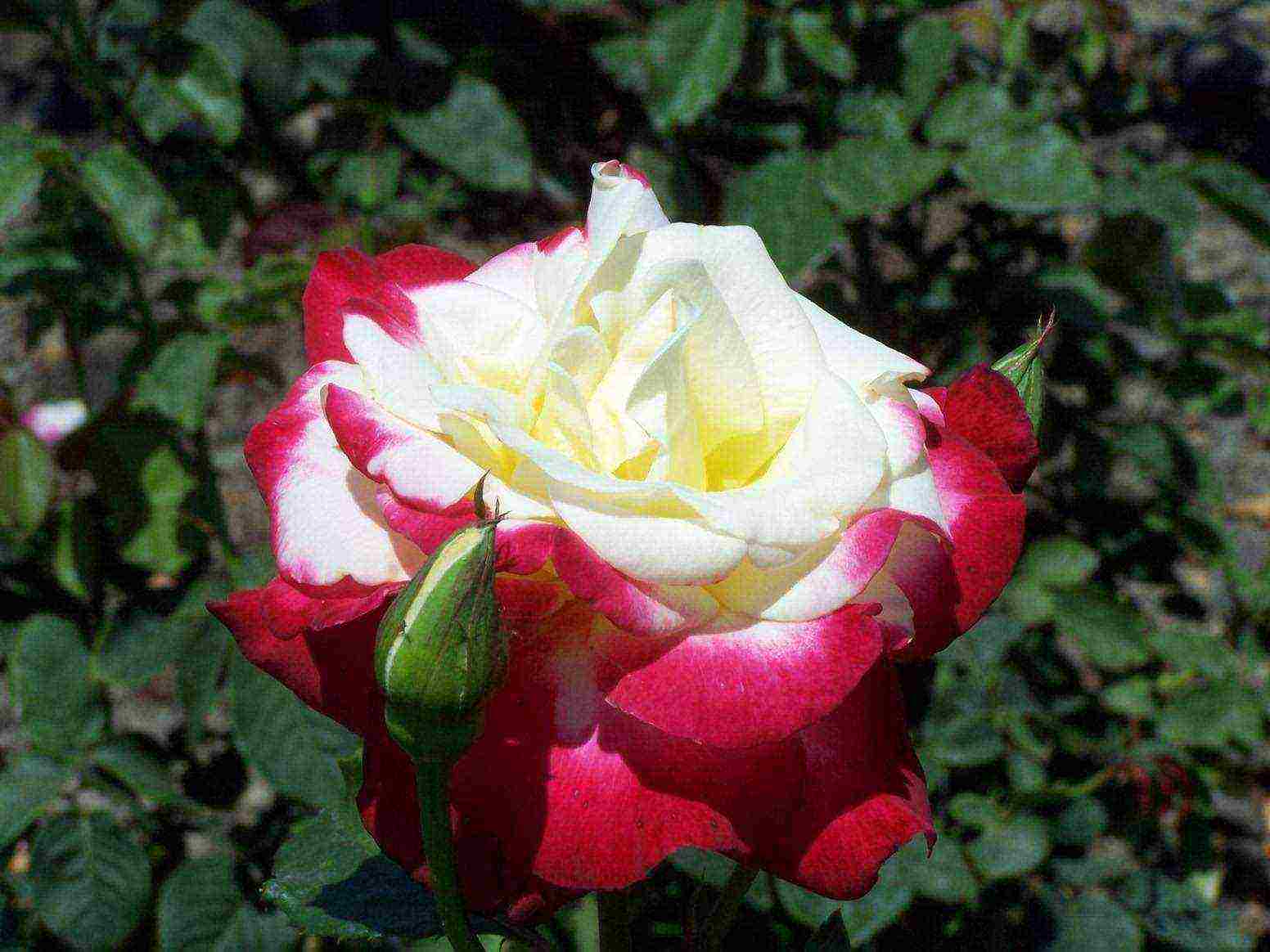 Tea rose Double Delight. Photo: Evergreen Nursery
Tea rose Double Delight. Photo: Evergreen Nursery
Tea roses come from China and India. These are evergreen non-frost-resistant plants that grow in open ground only in the extreme south (the Black Sea coast of the Caucasus and Crimea), where they give good cutting material.
In addition to grafting, they reproduce well by cuttings, and therefore are quite suitable for growing indoors.In the North and in the Middle Lane, they are bred mainly under glass.
Shoots of many varieties are prone to climbing, which contributed to the creation of liana-like varieties. Among them there are undersized bush forms; the dwarf varieties are the smallest (up to 30 cm). Tea roses bloom in medium-sized, multi-colored flowers with a pleasant aroma, often sitting in several pieces on drooping pedicels.
Of the common varieties, one should point out such as Natasha Meshcherskaya, M. Koshe, Nifetos, Marie van Gutt, etc.
Monthly roses (Chinese roses)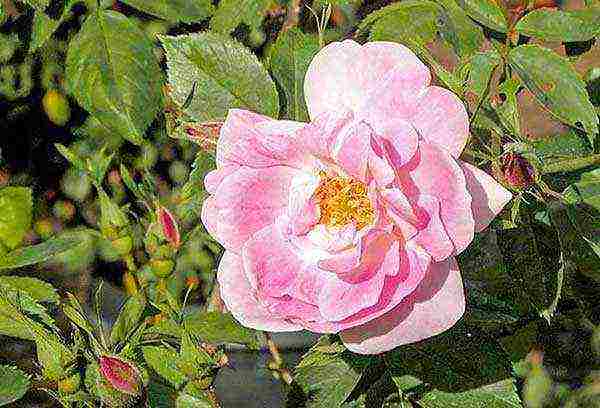 Rose Manetti. Photo: Cassandra Bernstein
Rose Manetti. Photo: Cassandra Bernstein
Monthly, Bengal, roses are native to China, and therefore are also called Chinese roses. Chinese roses are undersized (up to 50 cm high) evergreen non-resistant shrubs, similar in many properties to tea roses.
Monthly roses bloom profusely and for a long time in medium-sized white, pink and red double flowers with a pleasant weak aroma.
Bengal roses propagate mainly by cuttings, therefore they are suitable for growing in a room.
Monthly roses are divided into types:
- constantly blooming rose - a type with small pink double flowers, often found in apartments;
- long-leaved rose - with dark pink double flowers;
- dwarf rose - up to 50 cm high, with simple or double flowers;
- rose Manetti - vigorous, with dark pink semi-double flowers, propagated by cuttings; recommended as a rootstock for forcing roses;
- bourbon rose - is a hybrid of the monthly and gallic rose; there are varieties with climbing branches;
- noisette rose - usually climbing plants up to 1.8 m high with small flowers collected in a brush; a hybrid of monthly and musky roses, has strong growth and continuous flowering.
Previously, Chinese roses were widespread in culture, recently they have been supplanted by polyanthus and tea roses.
Repair roses
Repaired roses are obtained by crossing a tea rose with roses of the Gallika group, form long-stemmed shoots with large flowers of various colors.
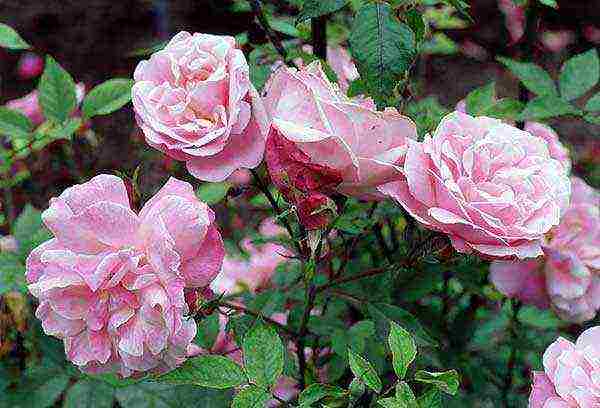 Repaired roses. Photo:
Repaired roses. Photo:
Repaired roses winter well in the South; in the North-West and in the Middle Lane they require reliable shelter, and therefore they are usually grown here under glass.
Repaired roses bloom 2 times a year: in early summer and late summer - early autumn.
The oldest varieties of remontant roses are Ulrich Brunner Filet (with large red flowers) and Frau Karl Druschki (with very large, odorless white flowers). The latter variety is easily affected by powdery mildew.
Of the domestic varieties, Dobrynya Nikitich, Trekhgorka remontantnaya, Polina Osipenko, etc. belong to the group of remontant roses.
Hybrid tea roses
Hybrid tea roses originated from crossing tea roses with remontant roses, they have many varieties - over 10,000 varieties.
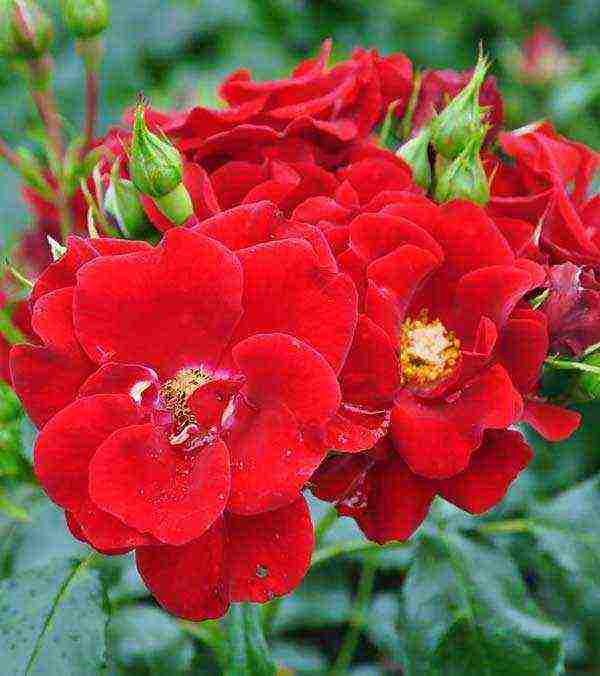 Hybrid tea rose, variety Matador. Photo: Vnukovo kennel
Hybrid tea rose, variety Matador. Photo: Vnukovo kennel
Hybrid tea roses have strong growth, richness of shapes and colors of flowers, greater endurance than tea roses, and long, abundant, flowering from mid-summer to autumn frosts. With skillful shelter in drained soils, many varieties of hybrid tea roses tolerate winter well in the Moscow region and in the North-West.
Many varieties of hybrid tea roses are grown in greenhouses for cut. Climbing varieties are found among them. Propagated by grafting on an ordinary rosehip stock. The ancestor of this group of roses was the beautiful La France variety.
Of the common varieties of hybrid tea roses, one can point to such as Lauren Karl, Hadley roses, Matador, Heath Majesti, Golden Ophelia, etc .; domestic: Grace, rose "A", N. K. Krupskaya, M. P. Nagibina and others.
Pernetsian roses
Pernécian roses are bred by crossing the remontant rose Antoine Dychet with large brilliant pink flowers with the yellow capuchin rose Persin Yellow and re-crossing the resulting Soleil d'Or hybrid with hybrid tea roses.
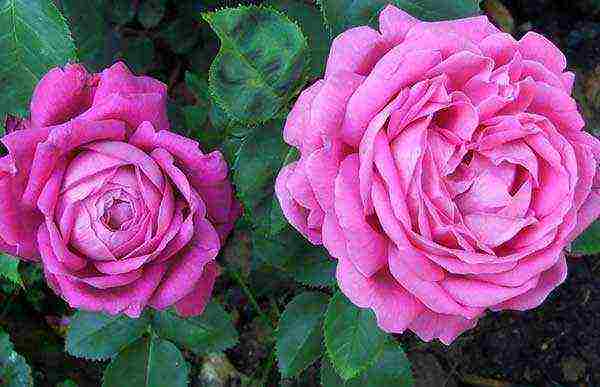 Pernetsian rose, cultivar Antoine Ducher (Ducher, 1866).
Pernetsian rose, cultivar Antoine Ducher (Ducher, 1866).
Pernetsian roses have flowers of yellow, orange, golden, chocolate, scarlet tones. They are cultivated as widely as hybrid tea. The receipt of many new crosses with hybrid tea roses led to the fact that the groups almost merged, and therefore it is difficult to determine the belonging of many varieties to one or another group. In the south, they winter well.
Famous varieties belong to the group of Pernetsian roses: Kabardinka Svyatogor, Souvenir de Claude Pernay, Ville de Paris, Velvetnaya, Krasavitsa, etc.
Polyanthus roses
Polyanthus roses are low-growing plants (up to 50 cm high), although there are some varieties up to 1 m high among them. The origin of polyanthus roses is hybrid - from crossing hybrid tea roses with multi-flowered ones.
The most typical varieties of polyanthus roses are characterized by small, double, unscented, flowers of various colors, folded into large paniculate inflorescences.
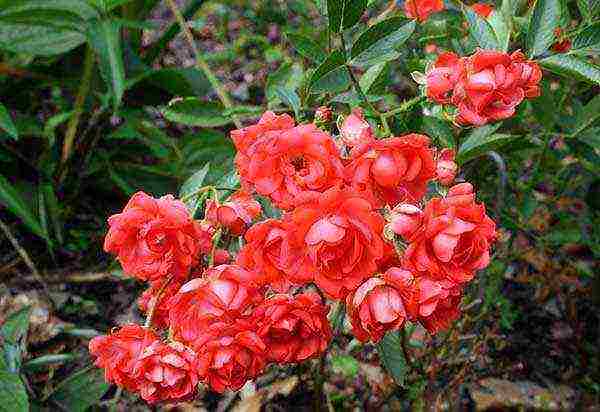 Polyanthus rose, Gloria Mundi variety.
Polyanthus rose, Gloria Mundi variety.
By the nature of the inflorescences, polyanthus roses can be divided into two groups:
- large-flowered, similar to hybrid tea roses;
- small-flowered, close to multi-flowered roses.
Polyanthus roses bloom profusely and for a long time. Polyanthus rose hybrids bloom in the first summer after sowing the seeds.
Polyanthus roses are propagated by cuttings and by grafting. Plants are quite resistant to fungal diseases. Good for indoor culture. Frost resistance of polyanthus roses is higher than that of hybrid tea roses, they can winter under cover in the North-West.
The best varieties of polyanthus roses are: Gloria Mundi, Clotilde Super, Edith Kavel, Ideal, Goldlax, etc .; domestic - Fedor Gubonin, Valentina Gubonina, Praskovya Gubonina, Voronezh Dawn, etc.
Miniature roses from China
Miniature roses native to China are low-growing plants, up to 30 cm high; flowers - terry small, up to 3 cm in diameter, from snow-white to bright red, collected in inflorescences (from 2 to 10 pieces). They reproduce vegetatively.
When grown outdoors, they need good protection. Can be grown and kept indoors. Varieties - Little Bakker, Roslin June Time.
Rose grandiflora
Rose grandiflora is a hybrid of hybrid tea and floribunda roses. They differ from their parents in greater height (up to 150 cm). Flowers - large (up to 15 cm in diameter), double, collected in inflorescences. When grown outdoors, they need light cover.
 Rose grandiflora, Queen Elizabeth variety. Photo: Vnukovo kennel
Rose grandiflora, Queen Elizabeth variety. Photo: Vnukovo kennel
Roses of grandiflora reproduce vegetatively, suitable for rose gardens, single and group plantings. Varieties - Queen Elizabeth, Stella, Samurai.
Floribunda rose
Floribunda rose is a hybrid of multi-tiered selection when crossing hybrid tea, polyanthus and other types of roses. Height - from 30 to 90 cm. Flowers are collected in multi-flowered corymbose inflorescences. The flower resembles hybrid tea roses in shape and size.
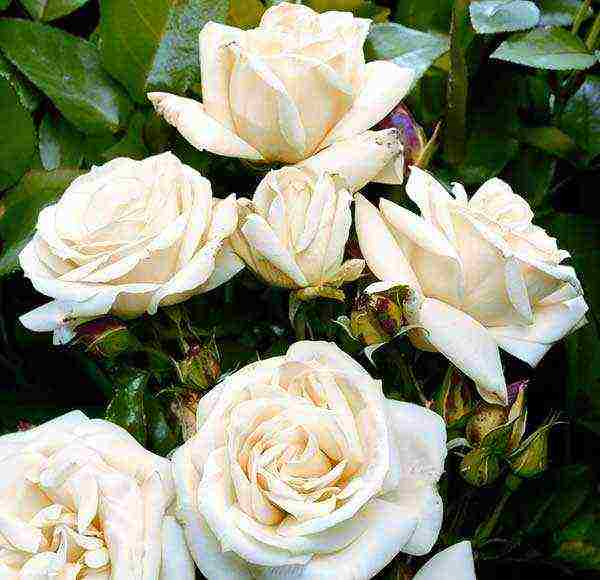 Snow-white flowers of a floribunda rose, cultivar La Paloma 85. Photo: First seeds
Snow-white flowers of a floribunda rose, cultivar La Paloma 85. Photo: First seeds
The color of the flowers of the floribunda rose is varied: from snow-white to orange. Flowering is constant, abundant during the growing season.
Floribunda roses are propagated vegetatively: by layering and grafting. When grown outdoors, they need light cover. Varieties - Gimini Cricket, Ama, Alain, La Paloma.
Rosa cardesa
Rosa cardesa is a hybrid of multi-tiered selection when crossing floribunda roses, climbing large-flowered, musk roses, etc. The height of the bush is 1.5–2 m.
Cardes roses have elegant dark green glossy leaves that adorn the bush before blooming. Flowers are large (6-9 cm), double (30 to 80 petals), collected in small inflorescences (2-5 pcs.). Abundant flowering, continuous during the growing season.
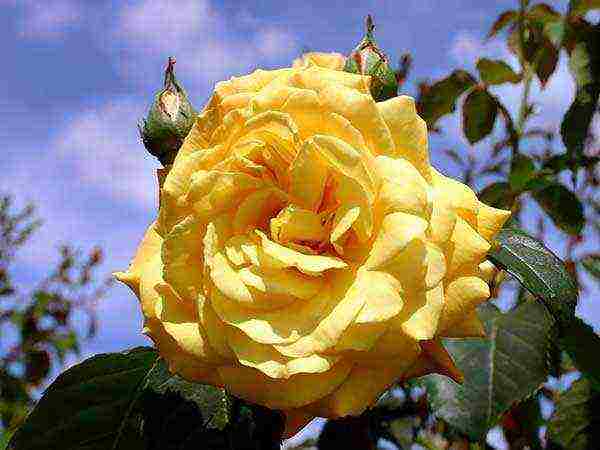 Rose of Cades, Goldstern cultivar. Photo: First seeds
Rose of Cades, Goldstern cultivar. Photo: First seeds
Cardes rose bushes are winter-hardy, do not require special shelter, and are resistant to diseases. This group of roses is suitable for areas with harsh climates.
Cardes roses are planted in groups and singly, tall stems are spectacular.Varieties - Goldstern, Ilse Kron Supernar, Simpati, Karlerue.
Reproduction of roses
Roses are propagated by seeds, stem and root cuttings, dividing bushes, layering and by grafting.
All rose hips and natural park rose species are propagated by seed. Many of them are capable of reproduction by root suckers, dividing bushes, cuttings and layering.
Wilds or rose hips for rootstocks are grown from seeds; only in the southern regions, rootstocks are often grown from cuttings (Sukhumka rose).
Liana roses are propagated mainly by layering; in the same way, double, centifol and damask roses are usually propagated, as well as improved forms of wrinkled roses, the "Queen of the North" rose, the park rose "Maiden's Blush" and sometimes remontant roses.
Noble roses are propagated by grafting, and varieties of indoor roses are propagated by cuttings.
Growing rootstock for roses
Rosehip is used as a rootstock for grafting noble roses. Michurin IV recommended a milky rose as a rootstock.
In the north, rootstocks can be: red-leaved rosehip and, for breeding standard roses, cornifolia rose. Sometimes they use the Ural rosehip, which is a special form of cinnamon rose.
Root stocks for roses should have a good root system, if possible without root growth, have a fast and strong growth, a smooth root collar, for northern conditions - sufficient winter hardiness, and for areas with an arid climate - drought resistance. In addition, the rootstocks must be immune to fungal diseases. None of the listed rose hips fully meets the specified requirements.
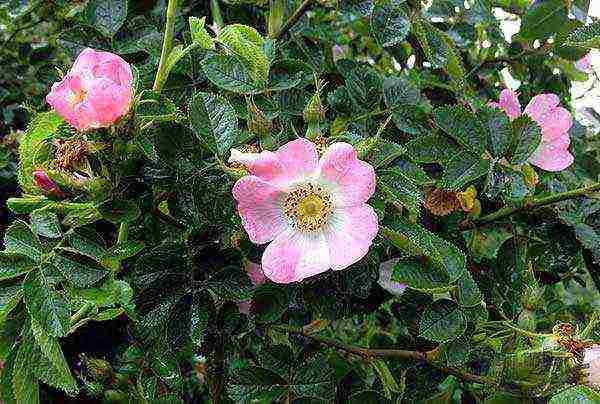 Rosehip is the best rootstock for a rose. Photo: Bruns Pflanzen
Rosehip is the best rootstock for a rose. Photo: Bruns Pflanzen
When breeding roses for rootstock, use wild rose from the North Caucasus. In northern conditions, the common dog rose is not winter-hardy enough, forms abundant root shoots and is affected by fungal diseases, especially powdery mildew. For the rest of the indicators, the common rosehip is perfect stock.
Rosehip seeds emerge in a year and not always completely, therefore, after collecting and extracting from the fruits, they are immediately stratified. Duration of stratification is 7–8 months. The germination rate is 85%.
With early autumn stratification, sowing is carried out in the spring, with winter - in the fall. Seeds from unripe fruits, collected at the beginning of the reddening, when sown in autumn, sprout next spring.
Stratified rosehip seeds are freed from the substrate and sown on the ridges in rows at a distance of 15–20 cm from each other, embedding them to a depth of 4–5 cm. An area with loose, rich soil is set aside for the ridges.
In the spring, as soon as the seedlings (wildfishes) develop 2-3 true leaves, a pick is made according to the scheme 20 × 6-8 cm. The main root is pinched at a third of its length.
In northern conditions, cut seedlings are grown on ridges for 2 seasons, in southern ones - 1 year.
The planted game is carefully looked after during the summer. Pruning of wild animals intended for budding into the neck is carried out immediately after their rooting. All emerging lower shoots are cut out.
2-3 weeks before budding, low-lying lateral shoots are cut out, thereby preparing a bole 15 cm high from the root collar. Shoots that interfere with budding are also cut or shortened.
For 1.5-2 weeks before budding, the plants are spud to make the bark easier to separate in the wild. On the eve of budding, the wilds are uncooked and watered in case of dry weather.
Budding
Budding is produced late July - Augustwhen the bark is well separated on the stock. Before budding, the soil is cleaned of weeds and the stems of the rootstocks are wiped with a rag.
Eyes are cut from cuttings taken immediately before budding from forcing greenhouse roses or grafted in winter. After budding, the root collar is covered with earth.
For the winter, the eyes should be well spud and insulated. In the spring of next year, they are bored and the wilds are cut off to a vaccinated eye.
Oculant (noble shoot) pinch in the spring over the third sheet, as a result of which a good rose bush develops by the fall. Overwintered rose flowers bloom profusely next year.
Winter grafting of roses
In October and November, the best sorted wilds are planted in high, 11-15 cm pots. For standard and half-stem roses, use the strongest rootstocks with one shoot, and for bush roses, with three or four.
The soil is prepared in the form of a mixture: heavy turf, humus and leaf (3: 1: 1) with coarse sand. Good results are obtained by adding horn shavings to it. The soil in pots is compacted.
Root stocks in basements at a temperature of + 7-10 ° C. Plants are well watered, laid on their side and sprayed with warm water twice a day. 10-15 days before grafting, the rooted plants are placed in the light.
The temperature is raised to + 20 ° C. As soon as the bark begins to detach easily (usually when shoots are 8–10 cm long), they start grafting. To do this, use cuttings taken in November-December when pruning wintering roses in the cellars.
The best time for winter grafting of roses is from late December to mid-February.
The grafted plants are placed on their side under the paper, maintaining a temperature of + 18 ... 20 ° C and systematically sprayed. The stalk grows together with the stock in 15–20 days, as evidenced by the young shoots of the scion. Such plants are installed vertically, spraying is reduced, and with the onset of warm sunny days, it is completely stopped, after which normal watering is performed.
Grafted roses, so as not to weaken them, the buds are removed, although in strong specimens, shoots with buds can be cut.
In the spring, when frosts pass, roses in pots are transferred to open ground, where they are dug into the ridges. In August, they are taken out of the ridges and set on level ground, and in case of rainy weather they are laid on their side for better ripening.
In the fall, with the onset of cold weather, they are brought into disinfected cellars, where they are kept until distillation at a temperature of + 2-3 ° C.
In December, the roses are cut and set for distillation. For cutting in the summer, roses are grown in the open field.
Ground culture of roses
For summer cutting in the open field, varieties of remontant, hybrid tea and Pernetsian roses are grown, as well as winter-hardy varieties (Ulrich Brunner Fillet, Frau Karl Druschki, Clotilde Super, Hadley roses, M. J. Boucher, Grussan Teplitz, etc.).
For planting roses, choose a drained, protected, well-lit area with clayey calcareous, sufficiently fertilized soil; it is processed to a depth of at least 40-50 cm.
N.I.Kichunov considered one of the most important conditions for the successful cultivation of noble roses in the open field pipe drainage device, through which not only excess water would flow down, but also warm air could freely penetrate into the soil; he called him warm drainage.
Roses are planted in spring. When planting, depending on the climate and variety, different feeding areas are provided.
For better and economical protection of roses for the winter, they are planted as densely as possible: remontant and other vigorous varieties - at a distance between rows of 60 cm, in rows of 40 cm; tea-hybrid and other less vigorous - between rows 50 cm, in rows 30 cm; typical polyanthus - 40 cm is enough between the rows. At the same time, it must be remembered that too dense planting leads to stagnant air and contributes to the development of diseases and pests.
During the summer behind the roses carefully looked after... In order to stop growth earlier, feeding is stopped from August. In the complex of measures for caring for roses, work on pruning and sheltering them for the winter is very important.
Summer residents and gardeners love to decorate their backyards with flowers. In many courtyards, you can see large flower beds and flower beds. Some people even create indescribable beauty from flowers, forming flower beds of continuous flowering. One of the main beauties is the rose. She is rightfully considered the queen of the flower world. It is she who, to a greater extent, is given special preference by both amateur gardeners and professionals.Therefore, many people want to choose the best varieties of roses. How to make the right choice and what should be considered?
The main criterion for the abundant flowering of the bush is the environment and soil characteristics. As many gardeners note, no matter which variety of roses is chosen, you can create a fertile soil for it yourself and concentrate the beds anywhere you want. Thus, the problem with the difference between the flowers you like and the soil conditions unsuitable for them is solved.
Roses with so-called complex colors are very demanding to the composition of the soil. The petals of such flowers have a combination of several shades. They can be very different and combine smooth or sharp transitions. Modern breeders have learned to breed amazing species of this plant, which have not only complex coloring, but also an incredible shape. On unsuitable soil, such plants acquire a depressed state, an unsightly shape and a dull color. Their life cycle is significantly shortened.
Very often people choose David Austin roses. The varieties of these flowers are intended mainly for cultivation in partial shade and in loamy soils. Such conditions are typical for many other species. If we consider in general the soil conditions and the location of the flower bed, then these flowers love light breathing earth. It is categorically impossible to plant seedlings in clay, sandy and sandy loam soil, since it poorly permeates moisture and, practically, does not allow air exchange between the root system and the soil. Experts recommend, in this case, to carry out a double digging with the addition of chernozem, peat, sod land and well-rotted manure. In this case, the proportions should be kept approximately equal.
The best place to plant roses is on the southeast side of your patio, garden or backyard. The place should not be dark, shaded by buildings, trees or ornamental shrubs.
As for the climate, then the resistance of a particular plant species to changeable weather conditions, to cold weather, heat and lack of air humidity should be taken into account. Are absolutely contraindicated for the colors of the place of north-western orientation at the summer cottage. Plants are very sensitive to drafts and cold winds, so roses will not grow well in such areas.
Classification of varieties of roses. What types are there and how to distinguish between them?
The opinions of many experts and florists boil down to the fact that before you start growing these beautiful flowers, you need to find out as much information as possible about them in order to avoid mistakes. After all, in the end, every grower, regardless of qualifications, wants to get high-quality, fragrant and beautiful roses. Species and varieties are divided into several categories. In each of them, there are the best options that have proven themselves on the positive side in all respects.
The most beautiful and common types of roses are:
- Floribunda.
- Hybrid tea.
- Grandiflora.
- Groundcover.
- Climbing.
- Shrubs.
- Selected by David Austin.
When choosing a variety, you must take into account your preferences and tastes, then your favorite flowers will appear on your personal plot.
Floribunda roses. Varieties, photos, description
The history of these flowers began in 1924, when the Danish originator by the name of Poulsen first bred the original flowers of this type, which were called hybrid-polyanthus. At first, they belonged to the general category of tea roses, and were bred into a separate group in 1976. Some experts note that floribunda roses are intermediate varieties between the two types (hybrid tea and climbing). A distinctive feature of these colors is the diversity in everything. This is especially true for the combination of shades and tones. As a rule, they are rich, colorful, juicy.
General characteristics. The height of the bushes varies from 40 cm to 1.5 m, about 35 inflorescences can be collected on one stem. The flowers themselves have from 8 to 24 petals, the edges of which are distinguished by medium doubleness.In shape, some varieties resemble a narrow or wide glass, while others can bloom with flat or cupped buds.
The description of floribunda rose varieties also shows that their individual specimens can have golden clear shades, which are distinguished by a glossy surface and rigid petals. Such plants have an average height (about 1 meter). They are also characterized by larger flowers that are collected in small inflorescences.
It should be noted that floribunda is a continuous flowering rose. They are also resistant to frost, fungal and viral diseases. This is an excellent solution for decorating your summer cottage or home yard.
The best floribunda roses, varieties with photos:
- Golden Vedding (Golden Wedding) German selection.
- Samba. Germany, selection W. Kordes.
- La-Paloma (La Paloma). Germany, breeding Tantau
- Lion-Rose. Germany, selection Kordes.
- Leonardo da Vinci. France, breeding Meilland.
- Tchaikovcki. France, breeding Meilland.
- Gebruder Grimm. Germany, selection Kordes.
- Pomponella. Germany, selection Kordes.
- Jubile du Prince de Monaco. France, breeding Meilland.
- Koncerto (Concerto). France, breeding Meilland.
- Purpl Tiger (Purple Tiger). France, breeding Meilland.
Hybrid tea roses: varieties, photos, description
This group has a very interesting history. Back in 1867, the Frenchman J.-B. André Guillot was engaged in the cultivation of flowers that were unique at that time. He experimented with La France for years, crossing remontant and tea roses. As a result, he created a wonderful plant that had many differences and its own unique zest. Then André Guillot positioned his brainchild as a variety of bourbon roses.
In the description of varieties of hybrid tea roses, their main feature is listed - the continuity of flowering. Also characteristic of these flowers are easily-cranked or straight stems, which have increased strength. They create erect, slightly spreading shoots. The varieties of hybrid tea roses were classified into a separate group in 1997.
The bushes are characterized by low shoots. Their length is slightly less than a meter, they have large racemes with 4-7 leaves. Most often, flowers are collected in small inflorescences of 4-6 pcs. The shades are very different (in some varieties, several colors can be combined). There are new varieties of hybrid tea roses that have complex large double flowers.
Almost all varieties of hybrid tea roses have a beautiful appearance and are perfect for decorating not only a summer cottage, but also premises. The average period of initial, active flowering lasts about a month. Then comes the time to move to the next stage - the emergence of new flowers (15 days for early varieties and 30 days for later). Then they bloom continuously until the first frost.
The best varieties of hybrid tea roses:
Medium-sized varieties:
Red-pink varieties:
Rose varieties of the Grandiflora group
A relatively new type of flowers, developed for decorating gardens. They look like a low-growing tree, about 1.5-2 m high. This group of flowers was obtained by crossing floribunda and hybrid tea varieties. Grandiflora embodies the best qualities of these varieties. They have a very attractive appearance and have a wonderful aroma. Notable properties are resistance to disease and frost.
The best varieties of Grandiflora roses:
Ground cover roses: varieties, photos, description
The name of this group contains the main answer to the question about the main characteristics of the plant. Groundcover - low-growing roses that are able to cover a vast area of the flower bed with long shoots with many flowers blooming on them. The length of the shoot can at times reach up to 4 meters. Thus, nature creates a natural, beautiful carpet.
There are also ground cover roses, varieties of which, in addition to creeping on the ground, shoot drooping shoots. This type of growth provides an indescribable beauty to the bushes. Some species bloom once a year (they are rarely used by summer residents).It is the continuously flowering varieties of ground cover roses that are very popular.
Roses also have ground cover varieties (see photo), which are characterized by a variety of shades (light pink or pale crimson, red and dark red, light red or pure white). The buds have a variety of sizes.
Another feature of these flowers is frost resistance. Many varieties do not shed their foliage until spring. They are good for decorating columns or walls in the yard. Despite this, the base of the plants should be covered for the winter.
Ground cover roses, winter-hardy varieties (photo):
Roses shrabs: varieties, photos
Speaking about this group of flowers, one can note their main feature - a magnificent aroma, neat, upright bushes, abundant and continuous flowering. Flowers can be of various shapes (there are small ones, and there are large ones, the diameter of which reaches 12 cm). Petals are double, semi-double or simple. The leaves do not have a glazed surface; they can be dark green with a burgundy tint.
It should be noted that shrub roses were introduced into a separate group in 1954. It was then that many very beautiful species of this plant appeared.
Due to its structure and powerful root system, the formation of a bush is very easy, the main thing is to cut it on time. For example, flower growers very often form a ball, cone or strict square. This is not difficult to do. Some summer residents use this plant to form a decorative hedge to highlight one or another area of the personal plot.
Roses are grown shrabs (see varieties with photos) summer residents, both in separate flower beds, and in combination with other types of flowers. They are often used in the planning of gardens or parks, which is why shrub roses are called landscape or park roses.
There are three groups of scrub (park) roses:
- Curly - the length of the shoots is from 5 to 16 m.
- Climbing - shoots length up to 6 m.
- Semi-plaited - the length of the zero shoot reaches a little more than 3 m.
Erect bushes can reach heights of up to one and a half meters. Among the advantageous properties is frost resistance (especially Canadian park roses, the varieties of which can withstand a temperature drop of up to 350 C of frost). They bloom all summer until late autumn continuously, delighting the eye with their indescribable beauty and aroma.
The best varieties of scrub roses:
Roses bred by David Austin
The origin of this group of flowers is very interesting. An English breeder named David Austin began breeding completely new types of roses. He experimented for a long time, crossing classic floribunda and tea hybrid with varieties of long-forgotten old French and Damascus roses, which have already lost their popularity and demand among gardeners and summer residents.
As a result of his hard work, flowers of a completely new format were obtained, which began to be called Austin roses. The varieties he bred have very attractive shapes, with intricate petals and the structure of the bud itself. They are also characterized by new aromas. Many experts compare the smells of these flowers with the aromas of expensive, natural and real teas.
The best varieties of Austin roses are very beautiful and are often grown for the trade. Despite the variety of forms of shoots, bushes and the abundance of flowering, the presentation of all varieties of rose leaves is not lost.
The work done by the English breeder has a great price. For example, breeding a single resistant variety requires 4 to 8 years of diligent attention and careful approach. Austin devoted his whole life to this business, which is more than 60 years. From a very young age, he started a business that brought him the most pleasure. The nursery he created, which is located in Shropshire, is still engaged in breeding new types of Austin roses. The catalog of varieties with photos is constantly updated with new types of these flowers, which have incredible beauty and advantageous properties.
It should be noted that the climatic location of Shropshire (western part of England) contributes to the endowment of Austin flowers with unique properties - resistance to severe weather conditions and diseases.
Austin roses, photo varieties:
Climbing roses: continuously flowering varieties
According to the description and characteristics, the budding and flowering phases of these beautiful plants are very extended. Shoot formation occurs constantly. This property contributes to the continuity of flowering. This period can last up to six months without interruption. Paying attention to this feature, many designers and flower growers use them to decorate complex and simple building elements of their homes and courtyards. The best, in this regard, are Climings or Banks.
Also, varieties of climbing roses that grow all summer can be divided into three groups according to the nature of their growth:
- Curly. The length of the shoots is up to 15 m.
- Climbing. Shoot length up to 5 m.
- Semi-plaited. The length of the branches does not exceed 3 m.
This classification is not accidental. The fact is that claimings bloom on young shoots, and ramblers use branches from past years. The approach to plant breeding and the formation of a beautiful, climbing bush depends on this nuance.
The most beautiful varieties of climbing roses:
This article provides a description and photo of the most popular, beautiful, fragrant and original varieties of roses. Therefore, flower growers and summer residents have a good opportunity to purchase those flowers that best suit his tastes and requirements.
It is not for nothing that the rose is called the queen of flowers, without her a garden is not a garden. The choice is now huge, there are more than 30 thousand varieties in the world, and about 100 new ones appear every year. These beauties are sold in all nurseries and garden centers, but not in every garden they can be found. Although many tried to grow, but some gave up: too whimsical.
In fact, roses are not that difficult to care for. You just have to choose the varieties that are suitable for our harsh conditions.
The well-known rose collector, Muscovite Alexei Stepanov, tested many different roses on his site and compiled a list of the most reliable ones. It included 30 varieties. And they all meet 5 main criteria:
1. Excellent health. This is one of the main qualities, since a sick rose does not just spoil the appearance of a flower garden, it also hibernates badly. Or even dies. After all, the affected leaves fall off ahead of time, and the plant simply does not have time to ripen.
2. Stable wintering. In different areas, in different conditions and with different shelters, they are still able to survive our severe frosts.
3. Abundant and long flowering. There are no such roses in nature to bloom without interruption all summer, but these varieties will inflate as long as possible.
4. Resistance of flowers to bad weather. They are not afraid of rains, moisture and heat - in any case, they retain their decorative effect.
5. Good shoot regrowth. This is important when the aerial part of the plant dies after an unsuccessful wintering. After all, the more new stems grow, the more flowers there will be.
So, roses that won't let you down.
Hybrid teaGloria deiMeilland, 1945 This unsurpassed masterpiece is called the number 1 rose in the world. She is really magnificent: her flowers are large, yellow with tints and pink edging of the petals.
The only drawback is that each flower lasts only 3 days.
Ingrid bergmanOlesen, 1984 Magnificent, dark red, with almost black buds - this is without exaggeration the best red variety for the middle strip. Perfect and inimitable. The bush grows quickly, the flowers last up to 2 weeks and are not at all afraid of rains.
AphroditeTantau, 2006 No wonder this rose was named after the goddess of love and beauty - she is the embodiment of beauty! Her flowers are 10–12 cm in diameter, porcelain-pink in color. They tolerate rain well. The bush is low, up to 80 cm.
Hommage a barbaraDelbard, 1997 Perhaps the best rose in the Delbard collection. Her flowers are delightful burgundy with black bloom and wavy petals.Each shoot blooms 1 bud, but there are always a lot of stems on the bush, the flowers last up to 2 weeks and are not at all afraid of rains.
FloribundaThere are 7 varieties in this group at once. They are delightful. They are resilient. They will decorate any garden!
Sangerhause jumbileumroseKordes, 2003 Its delicate, large (up to 9 cm in diameter) flowers in apricot-pink tones look very impressive against the background of dark green foliage. Branched bush. Not afraid of disease, heat or rain. Blooms all summer and is very abundant.
Leonardo da VinciMielland, 1993 As you know. Leonardo da Vinci was the greatest artist and ingenious inventor. And the rose, named in his honor, as if seeks to justify the high honor shown to her. Her bush is straight and compact. In the first bloom, it is literally strewn with bright pink pom-pom flowers, very close in shape to the old varieties.
The only drawback of this beauty is that she almost does not smell. But it never fails.
Lios-roseKordes, 2002 She is always included in the top ten charts compiled by a survey of rose lovers - in terms of reliability, she is not equal! Cream-white flowers bloom slowly on large clusters and change shape daily.
The disadvantage of a rose is that in the middle lane it wakes up much later than other roses, develops slowly and blooms only at the end of July. Therefore, it does not have time to bloom a second time. But in our harsh conditions, this disadvantage turns into a huge plus, because, failing to plant the buds again, the rose has time to prepare for the cold and always winters well.
PastellaTantau, 2004 The bush of this wonderful variety is very beautiful, with bright dark green foliage. Flowers 7-8 cm in diameter, unusual creamy white color with pinkish and green tints. They are collected in multi-member clusters that bloom profusely and continuously. The rose has excellent health and winters well.
Jubile du prince de monacoMielland, 2000 The main advantage of this rose is its "long-lasting" flowers, each of which lasts up to 2 weeks and at the same time constantly changes color: at the time of dissolution, they are white with a red edging, then turn red, and as they fade they become white-green.
The rose has two drawbacks - it does not smell and in unfavorable years it is affected by black spot. But on the other hand, it feels great in gray latitudes.
Gebruder GrimmKordes, 2007 This rose has been awarded the ADR quality mark, which is awarded to the most decorative and resistant varieties. Her flowers are unique yellow-orange-red color. Small, 6–7 cm in diameter, but always collected in large racemes. It always creates a bright accent in the garden, so it is better to plant it separately from other roses, for example, against the background of conifers. Otherwise, she will draw all attention to herself and other varieties next to her will be lost.
PomponellaKordes, 2005 It is short, but blooms very profusely. Her flowers are small, pom-shaped, intense pink, collected in large brushes of 15-30 pieces!
ShrubsThis group also has a fairly extensive selection of resistant and unpretentious roses - 7 varieties that will not let you down and will delight you with health and abundant flowering.
WesterlandKordes, 1969 A very spectacular and unusual rose - its bush grows quickly and blooms in two pronounced waves. The flowers are semi-double, copper-orange. And although each of them lasts only 3 days, they take in quantity - there are a lot of buds in the brushes and new ones are constantly replacing the fallen ones. In very harsh winters, it can freeze slightly, but quickly recovers. Possesses the ADR quality mark - for high decorative effect and durability.
AngelaKordes, 1984 The flowers of this wonderful rose are medium-sized, up to 4 cm in diameter, but an incredible amount of them is formed. They are bright pink in color, collected in numerous brushes, which cover the leaves. In catalogs in photographs, she usually does not look very presentable, and flower growers often bypass her with their attention. But those who planted were not disappointed - this is a real queen! Nothing sick and all in bloom. No wonder she was awarded the ADR quality mark.
Bonica 82Mielland, 1985 The ideal rose for beginners! She easily forgives mistakes in pruning and shelter for the winter, and every summer she pleases with abundant flowering. Her flowers are light pink, slightly fading. They are not large, 5–6 cm in diameter, but they open constantly, in any weather, right up to the snow!
The only drawback is that it doesn't smell at all.
Rhapsody in blueFrank R. Cowlishaw, 1999 This is the only blue rose in the top 30. And this is the bluest of all roses! More precisely, it is blue-violet. The flowers are not large, but collected in large brushes. Rain resistant. The bush grows up to 1.5 m and looks very impressive surrounded by dense yellow roses.
Louise Odier (Madame de Stella)Margottin, 1851 Notice the year it was bred - it is over half a century old! This is an old Bourbon variety that will give odds to many modern ones. Very hardy and winter hardy. It can even be left without shelter in the winter. The bush, of course, freezes above the snow level, but quickly recovers. With good cover, the plants are tall and very dense. The flowers of this rose are of an old cupped shape, 5–7 cm in diameter, dark pink in the center and lighter at the edges. And what a smell! Saturated, strong. By the way, it is from this variety that rose oil is most often made and jam is brewed.
LarissaKordes, 2008 It appeared on the market relatively recently, but has already managed to conquer gardeners with excellent health and abundant flowering. Its flowers are small, 5–6 cm in diameter, pale pink, densely double, old-fashioned, collected in large brushes. This variety will perfectly complement English roses with large flowers.
Guy SavoyDelbard, 2001 The only rose with striped petals to make it to the list of trusted varieties. It is so powerful that in France it is recommended to make hedges from it. In our conditions, it is, of course, a little more modest, but, nevertheless, it grows up to 1.5 m, forming very tough shoots. They cannot be bent down for the winter, so the bush has to be cut to the height of the shelter. The flowers of this rose are weakly double, but large, of a rare pomegranate shade with white strokes. Each brush contains 9–20 buds.
EnglishThis group included 5 varieties that showed themselves at their best in the harsh conditions of Russian reality.
Graham thomasAustin, 1983 This is one of the best breeding varieties of David Austin. Several years ago, he was the last, 14th in a row, to take a place in the World Rose Hall of Fame. It blooms very profusely. Its flowers are bright yellow, do not fade and are considered the standard of yellow in roses. In our climate, it will grow very quickly, reaching a height of 2 m.
Crown Princess MargaretaAustin, 1999 An incredible variety - during the flowering season, its shoots are covered with caps of densely doubled light orange flowers of an old shape with a strong aroma. It can be grown like a climbing rose, with minimal pruning, keeping the shoots from last year. At the same time, it will bloom almost along their entire length.
James galwayAustin, 1985 This variety in warm countries forms a powerful bush 2 m high and the same size in circumference. However, in Russia it does not work that way - the shoots are very hard and it is impossible to bend them to the ground, so you have to cut them to the height of the shelter. The flowers of this rose are cold pink, very fragrant, collected in a brush.
Mary roseAustin, 1985 This is one of the first varieties that brought David Austin worldwide fame. The qualities of the variety are outstanding. Tall and strong arched shoots create a beautiful bush shape. They fit easily for wintering. Cold pink flowers with a lilac tint fully convey the charm of real old roses. One of the first to bloom in the garden, and one of the last to finish flowering.
Crocus roseAustin, 2000 The most popular flowering rose in our country. A powerful, spreading bush grows quickly - this variety has never had problems with replacing shoots. Her flowers are white, with an orange center - they look just amazing!
GroundcoverThere is only one variety here - only it has fully shown itself to be reliable and very decorative.
Sunny roseKordes, 2001 This variety fully lives up to its name ("sunny" in translation from English - "sunny") - if you want to have a yellow carpet in the garden, then it was created especially for you! Pleases with abundant, almost continuous flowering. In brushes up to 12 large rich yellow, fading to creamy flowers. An adult bush covers an area of about 1 sq. m. It has the ADR quality mark.
ClimbingThere are quite a lot of reliable roses in this group - 6 varieties at once showed themselves at a height in our difficult climatic conditions.
FlammentanzKordes, 1955 A very spectacular rose with red petals. It blooms once, but so abundantly that it literally overshadows other roses! Her flowers are resistant to rain, open in any weather and stay on the bush for a long time. It grows well on its own roots and perfectly cuttings, so it wanders from garden to garden.
Rosarium UetersenKordes, 1977 Growing fast. It blooms profusely all season with bright crimson flowers. It is considered a petite, but in our climate it does not grow to the declared size and is usually grown as a scrub. Looks great and blooms on a trunk. Over time, its shoots become thick, they are difficult to lay, so the bush for the winter has to be cut to the level of the shelter.
Pierre de Ronsard (Eden Rose)Mielland, 1987In our conditions, its lashes reach 1.5–2 m. It looks beautiful on a lattice support, if you distribute the shoots on it in the form of a fan. But you can grow it in the form of a bush, tying it to vertical supports to protect it from the wind. By the way, it is often called the “rose of paradise”. Indeed, when you stand near an adult flowering bush, which is adorned with an abundance of creamy white flowers with a bright pink edge, it seems that such beauty can only be in paradise.
But this rose has 3 drawbacks: weak aroma, instability of flowers to rain, and thick shoots, which have to be bent for the winter in 2-3 doses.
JasminaKordes, 2005 This rose amazes with excellent health and abundant flowering - new shoots have caps of up to 50 buds! The flowers are medium-sized, cupped, with the most delicate pink-lilac tint and an amazing aroma! And what is more pleasant - the shoots fit well in the winter.
Dorothy perkinsJacksaon & Perkins USA, 1901 It is not without reason that this climbing rambler rose has been so popular in the world for more than 100 years - its powerful bushes 3 m high and more than 2 m wide are strewn from top to bottom with cascades of small, 3-5 cm in diameter pink flowers. The foliage is small, glossy and completely covered with flowers during flowering. Blooms once. Looks great on a high trunk - its long shoots gracefully hang down in a luxurious waterfall.
RaubritterKordes, 1936 This outstanding rose is over 80 years old, but it still drives flower growers all over the world crazy. Belongs to the group of ramblers. It blooms once, but very profusely. The flowers are medium-sized, 5–6 cm in diameter, resemble pompons in shape - they seem to have descended from old paintings. The shoots are very thorny and flexible, easily bend in any direction, so there are no problems with laying them for the winter.
P.S. Please note - most of the roses in the list of the rose collector Alexei Stepanov belong to the selection of Cordes. And this is not surprising, because the climate in Germany is closest to ours. Heat-loving French women are still lagging behind in disease resistance. And one more thing: in this list of reliable roses, as you noticed, there are no varieties of Canadian selection. But they are ideally suited for our harsh conditions. Yes, only their decorativeness, to put it mildly, for an amateur.
Based on materials from the magazine "Gardener Bulletin", April 2013
A florist always wants to have only the best types of flowers on his garden plot. Breeders have created winter-hardy roses specifically for growing in the Moscow region, in the Urals and Siberia, and other northern regions, where the climate, especially in winter, is rather harsh. In such places, only the most unpretentious and winter-hardy roses are able to survive normally. Today we will tell you more about the 5 most suitable flower varieties that are good for cultivation in low temperatures.
Rosarium Uetersen
If we talk about winter-hardy varieties of roses, it is worth mentioning the most unpretentious roses, which are called Rosarium Uetersen. They are very beautiful and can be seen blooming during the three summer months. Bushes grow quietly in any place designated for them on the site.
The culture belongs to the Climber group.Experienced gardeners often grow these frost-resistant flowers, the bushes of which can reach 3 meters in height, using the standard method. It is worth remembering such a feature of this most beautiful culture as a decrease in the size of inflorescences in the presence of too low air temperatures.
Westerland
What roses can still be considered the most suitable for the climate of the Moscow region, the Urals, Siberia? This is one of the famous varieties called Westerland. This rose is able to delight the grower with constant rich flowering. The appearance of the first inflorescences on the bushes should be expected fairly quickly after planting. At first, they are colored in a characteristic rich orange color. Over time, the color of this most winter-hardy flower changes to apricot.
Each specimen is about 10 cm in diameter. These perennial plants owe their appearance to the efforts of breeders from Germany. As the bushes grow, the gardener can create a true decoration of his garden from flowers. This species is not only the most unpretentious, but even has a special certificate in which this feature is spelled out.
New dawn
This type of flower stands out from other hybrid varieties. In the process of breeding it, breeders used distant relatives of this culture from America. The result was a magnificent specimen, endowed with such qualities as frost resistance, high immunity to diseases and pests; flowers that are beautiful in appearance and have a sophisticated aroma. The flowers of such winter-hardy plants are traditionally painted in pleasant pale orange and cream colors. Currently, a special variety is known - the white rose, - the flowering of which the gardener will be able to observe only once a year. Therefore, when making a purchase of seedlings, it is recommended to clarify whether these crops are continuously blooming.
William Shakespeare 2000
If you want to have in your flower garden one more rose that is the easiest to care for, at the same time resistant to low temperatures, and at the same time a beautiful culture, you should choose the William Shakespeare 2000 variety. This type of flowers comes from England. It was invented by breeder David Austin specifically for beginner growers who do not yet have much practical experience in growing such plants.
This species does not actually require complex planting of seedlings, complex care. It has a number of advantages: resistance to cold weather, draft, wind and other climate difficulties. He received a stable immunity to major diseases. The bush growing on the site is able to reach 1 meter in height and have a large number of inflorescences on the branches. The gardener gets the opportunity to admire the velvety flowers. Initially, they are colored red, but over time they acquire a delicate purple hue.
Golden Celebration
The fifth in the ranking of the most suitable species for giving, with the necessary characteristics, is Golden Celebration. These beautiful flowers also owe their appearance to the specialist David Austin. The culture is well suited for cultivation in the climate of the Moscow region. When carrying out simple care, the flowering of this beauty can be observed twice a year.
The flowers are usually rounded, rich in yellow, and have a caramelized aroma with a hint of lemon scent.
They appear on stems, the average length of each of which is about 60 cm. Such bushes grow and develop normally, regardless of the vagaries of the weather. They also practically do not get sick, which makes it easier for the grower to take care of his favorite plants, which is already easy.
Video "Rose Westerland"
In this video, you will hear a description of the Westerland rose.
